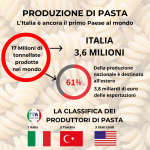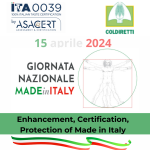2019 was a golden year for Italian agri-food exports. All the products of the Mediterranean diet have flown high, despite threats on the international markets in the UK and USA. Specifically, an unprecedented affirmation for the dairy sector that exceeded a foreign turnover of 3 billion + 11.2% compared to 2018. Great results for pasta too, with + 7.2% (2.6 billion) and bakery, biscuits and confectionery sector, which recorded export sales of 2.33 billion, + 11.7%. Italian wine is confirmed as a breakthrough striker in the foreign market: 6.43 billion, + 3.2%.
What will be of all these extraordinary results, will we have to forget that we are the producers and exporters of health, taste, authenticity, even culinary art? How will we manage to be still the nightmare of our neighbors from across the Alps, to overwhelm competition on tables all over the world?
Yes, because the coronavirus has arrived without knocking on the doors of the citizens of the whole world, upsetting the lives of billions of people, carrying a crowd of poor economies, as a train. Each state has shielded as much as it could, each government has worn its mask, metaphorically speaking, in order to ward off economic and biological contagion as well as it could. There was nothing to do, the lockdown implemented around the world, in a more or less stringent way, was an asphyxiating mask for the interconnected and global economies. What happens in China inevitably has its effects on the production and exports of the whole world. Remaining in Europe, it seems that the interdependence and the delocalization of the production – or part of it – has also put the giants of the four wheels in serious difficulty: the closure of the companies that deal with components in Italy and Spain does not allow the German factories (that will reopen after Easter) to be able to resume normal production activities.
With regards to the export sector, there is also a logistical problem, a sector which, far from being completely automated, requires human intervention not so much for the movement of goods, which also has its importance, as for programming and service optimization. The human factor is, however, at the time of the coronavirus, an element that carries within itself an inescapable imponderability: if the virus hits a worker, the entire warehouse stops for quarantine.
The picture gives even more honor to the Italian agri-food sector, which has incorporated and made its own those characteristics of resilience and perseverance, typical of natural processes, which the operators of the sector respect and enhance. Italians continue to find fresh products on supermarket counters and prices continue to be acceptable. How long will it be possible to guarantee the supply? Not for much longer, according to authoritative exponents of the agri-food world. It is feared that the consolidation of the difficulties in the export of Italian goods, due to endogenous factors, and the obstacles to the importation of the same by foreign countries (implemented more or less maliciously), could push a vacuum on the shelves of foreign supermarkets. Thus, our products could soon be replaced with terrible fake products, feeding the already thriving Italian Sounding market.
“It is right now that the most important game is played. It is necessary to fight with all energies the assault on diligence by jackals to grab those spaces left free on the shelves. Once empty, once filled with the various Borgonzola, Salsa Pomarola, Zottarella and Spagheroni, it will be difficult to replace with genuinely tricolor products. The producers alone will not make it.” Says Fabrizio Capaccioli MD ASACERT and creator of the ITA0039 certification system. In short, a massive investment in foreign marketing campaigns in favor of the extraordinary patrimony of Italian agri-food goods must be urgently allocated, deburocratised funds must be made immediately available for companies that export and encourage the reconversions of traditional companies in e-commerce. Support companies, providing them with expert guide agencies, who take entrepreneurs by the hand and lead them safely on the path towards internationalization.
Capaccioli concludes: “Now more than ever, the safeguarding of true Italian restaurateurs abroad must be protected more effectively, thanks to effective, tested tools entrusted to qualified and specialized companies. We cannot afford gaps in the Made in Italy enhancement system, no more. All processes must be carried out systematically and scientifically, I dare say. A question that becomes vital for the survival of Italian restaurateurs who operate all over the world and for the entire HoReCa Made In Italy sector which, in its interconnections, is a driving force for all agri-food production“.






